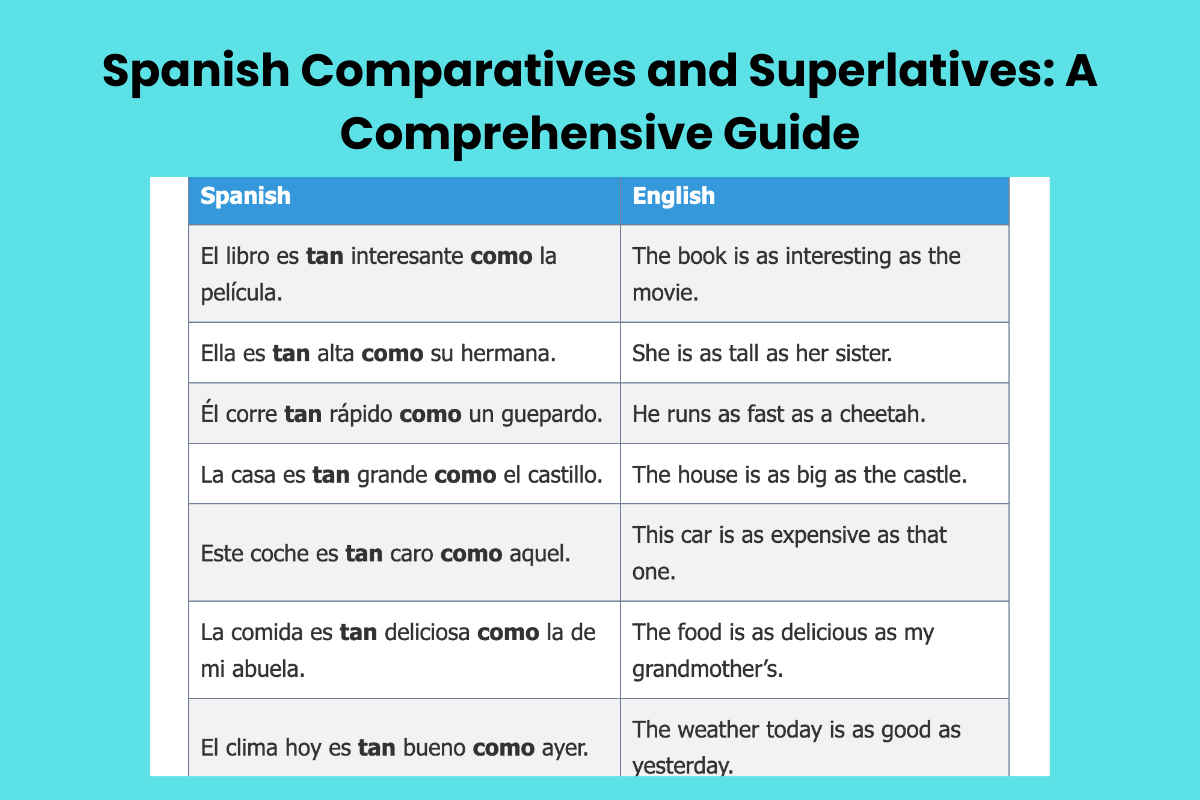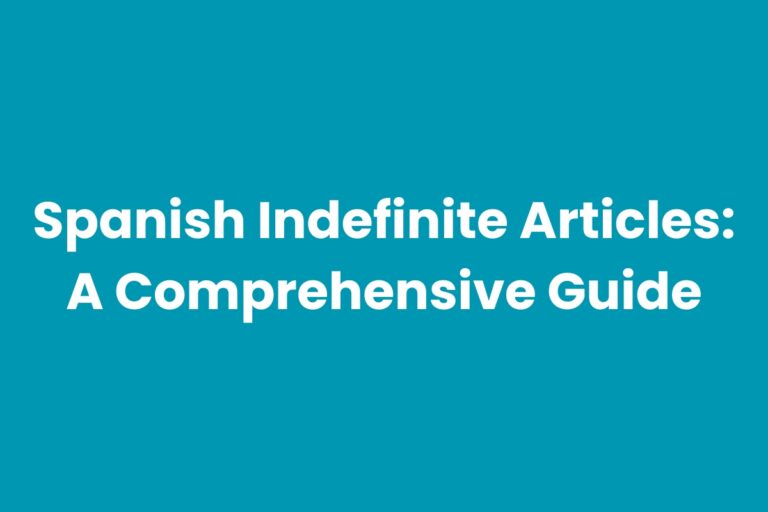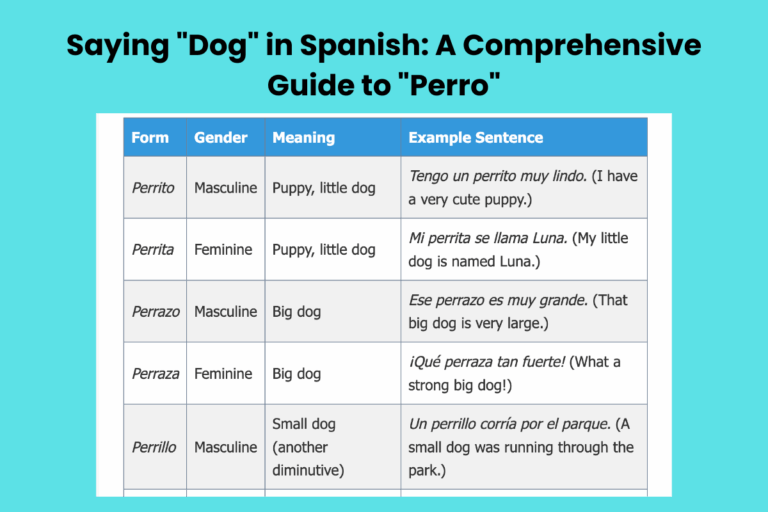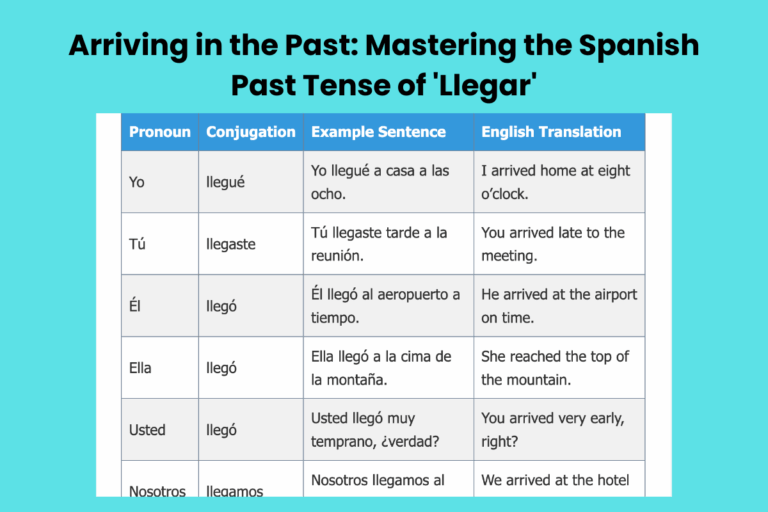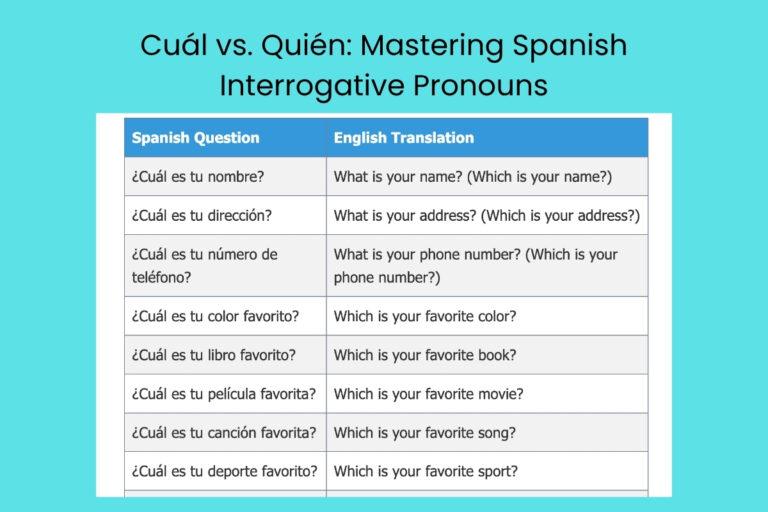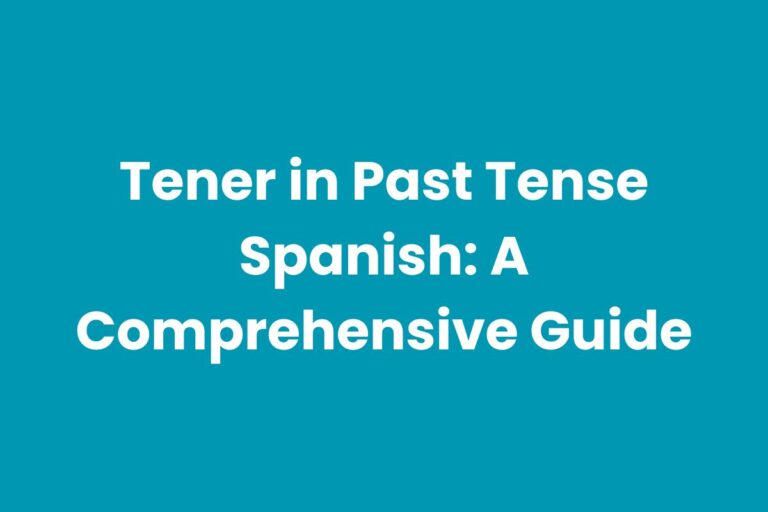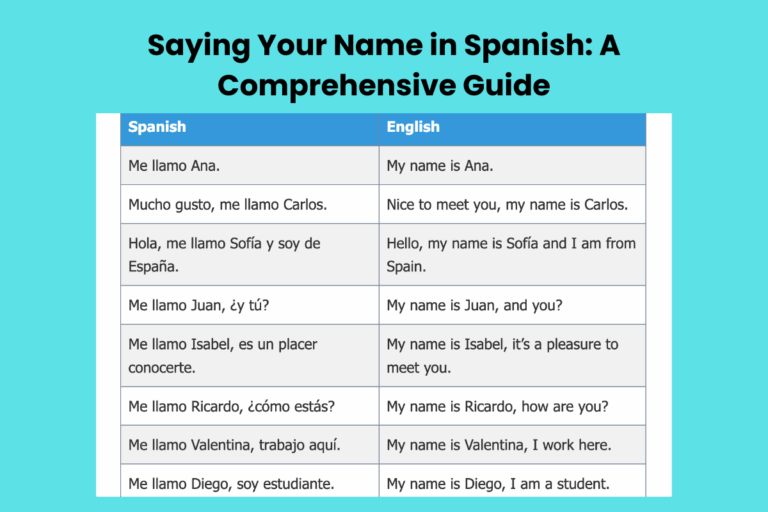Spanish Comparatives and Superlatives: A Comprehensive Guide
Understanding comparatives and superlatives is crucial for expressing degrees of comparison in Spanish, allowing you to describe how things are similar or different. This knowledge is essential for constructing more complex and nuanced sentences, enhancing your ability to communicate effectively.
This guide is designed for students of all levels, from beginners seeking to grasp the basics to advanced learners aiming to refine their proficiency. By mastering these grammatical structures, you will significantly improve your fluency and accuracy in Spanish.
Table of Contents
- Introduction
- Definition of Comparatives and Superlatives
- Structural Breakdown
- Types and Categories
- Examples
- Usage Rules
- Common Mistakes
- Practice Exercises
- Advanced Topics
- FAQ
- Conclusion
Definition of Comparatives and Superlatives
Comparatives are used to compare two or more nouns (people, places, things, or ideas) to show which has more or less of a particular quality. They express a relationship of superiority, inferiority, or equality between the compared entities. In Spanish, comparatives are formed using specific structures involving adjectives and adverbs to indicate these differences.
Superlatives, on the other hand, are used to indicate that a noun has the highest degree of a particular quality within a group. They express the extreme end of a spectrum, showing that something is the best, worst, biggest, or smallest among the items being considered. Spanish superlatives utilize distinct grammatical constructions to convey this sense of being the “most” or “least” of something.
Comparatives and superlatives are essential components of descriptive language, allowing for precise and nuanced communication. They enable speakers and writers to express opinions, make judgments, and provide detailed descriptions.
Mastering these grammatical forms is crucial for achieving fluency and accuracy in Spanish.
Structural Breakdown
Comparative Structures
Spanish comparatives generally follow a specific structure depending on whether you’re comparing equality, superiority, or inferiority. The basic components include words like más (more), menos (less), tan (as), and como (as).
- Superiority: más + adjective/adverb + que (more + adjective/adverb + than)
- Inferiority: menos + adjective/adverb + que (less + adjective/adverb + than)
- Equality: tan + adjective/adverb + como (as + adjective/adverb + as) or tanto/a(s) + noun + como (as much/many + noun + as)
For example, to say “Maria is taller than Juan,” you would use the structure for superiority: “Maria es más alta que Juan.“
Superlative Structures
Superlatives in Spanish are formed in two main ways: relative and absolute. Relative superlatives compare one thing to all others in a group, while absolute superlatives express a very high degree of a quality without comparing to a specific group.
- Relative Superlative: el/la/los/las + más/menos + adjective + de + group (the most/least + adjective + of + group)
- Absolute Superlative: adjective + -ísimo/a(s) (very + adjective) or using adverbs like muy (very) or sumamente (extremely)
For example, to say “This is the most beautiful beach in the world,” you would use the relative superlative: “Esta es la playa más bonita del mundo.” To say “This house is very big,” you would use the absolute superlative: “Esta casa es grandísima.” or “Esta casa es muy grande.“
Types and Categories
Comparatives of Equality
Comparatives of equality indicate that two things are equal in a particular quality. The structure tan + adjective/adverb + como is used to compare adjectives or adverbs, while tanto/a(s) + noun + como is used to compare nouns. The form of tanto must agree in gender and number with the noun it modifies.
Example: “El libro es tan interesante como la película.” (The book is as interesting as the movie.) Here, the adjective interesante is being compared using tan…como.
Comparatives of Inequality
Comparatives of inequality express that one thing has more or less of a particular quality than another. These are divided into comparatives of superiority (más…que) and comparatives of inferiority (menos…que).
Example of Superiority: “Mi coche es más rápido que el tuyo.” (My car is faster than yours.) Here, más rápido que indicates that my car possesses a greater degree of speed.
Example of Inferiority: “Esta tarea es menos difícil que la anterior.” (This task is less difficult than the previous one.) Here, menos difícil que indicates that this task possesses a lesser degree of difficulty.
Relative Superlatives
Relative superlatives compare one noun to all others within a group, indicating that it has the highest or lowest degree of a certain quality. The structure el/la/los/las + más/menos + adjective + de + group is used, with the definite article agreeing in gender and number with the noun being described.
Example: “Ella es la estudiante más inteligente de la clase.” (She is the most intelligent student in the class.) Here, la estudiante más inteligente shows that she surpasses all other students in intelligence.
Absolute Superlatives
Absolute superlatives express a very high degree of a quality without comparing to a specific group. This is often achieved by adding the suffix -ísimo/a(s) to the adjective, or by using adverbs like muy, sumamente, or extremadamente before the adjective.
Example using -ísimo: “El examen fue dificilísimo.” (The exam was extremely difficult.)
Example using muy: “El examen fue muy difícil.” (The exam was very difficult.)
Examples
Examples of Comparatives of Equality
The following table provides examples of comparatives of equality, demonstrating the use of tan…como and tanto/a(s)…como.
| Spanish | English |
|---|---|
| El libro es tan interesante como la película. | The book is as interesting as the movie. |
| Ella es tan alta como su hermana. | She is as tall as her sister. |
| Él corre tan rápido como un guepardo. | He runs as fast as a cheetah. |
| La casa es tan grande como el castillo. | The house is as big as the castle. |
| Este coche es tan caro como aquel. | This car is as expensive as that one. |
| La comida es tan deliciosa como la de mi abuela. | The food is as delicious as my grandmother’s. |
| El clima hoy es tan bueno como ayer. | The weather today is as good as yesterday. |
| Mi trabajo es tan importante como el tuyo. | My job is as important as yours. |
| El café es tan amargo como lo esperaba. | The coffee is as bitter as I expected. |
| La música es tan fuerte como en un concierto. | The music is as loud as at a concert. |
| Tengo tanto trabajo como tú. | I have as much work as you. |
| Hay tantas personas aquí como en el estadio. | There are as many people here as in the stadium. |
| Compré tantos libros como pude cargar. | I bought as many books as I could carry. |
| Ella tiene tantas ideas como un genio. | She has as many ideas as a genius. |
| Él tiene tanto dinero como un banco. | He has as much money as a bank. |
| Esta película tiene tantos efectos especiales como la última de Hollywood. | This movie has as many special effects as the latest Hollywood film. |
| La ciudad tiene tantos habitantes como un país pequeño. | The city has as many inhabitants as a small country. |
| El jardín tiene tantas flores como un paraíso. | The garden has as many flowers as a paradise. |
| La fiesta tiene tanta comida como para un banquete. | The party has as much food as for a banquet. |
| El proyecto requiere tanta atención como un bebé recién nacido. | The project requires as much attention as a newborn baby. |
| Hay tantos coches en la carretera como en un estacionamiento. | There are as many cars on the road as in a parking lot. |
| Él tiene tanta paciencia como un santo. | He has as much patience as a saint. |
Examples of Comparatives of Inequality
The following table provides examples of comparatives of inequality, demonstrating the use of más…que and menos…que.
| Spanish | English |
|---|---|
| Mi coche es más rápido que el tuyo. | My car is faster than yours. |
| Esta tarea es menos difícil que la anterior. | This task is less difficult than the previous one. |
| El café es más caro que el té. | Coffee is more expensive than tea. |
| Ella es menos habladora que su hermana. | She is less talkative than her sister. |
| Este libro es más interesante que ese. | This book is more interesting than that one. |
| Hoy hace menos frío que ayer. | Today is less cold than yesterday. |
| La ciudad es más grande que el pueblo. | The city is bigger than the town. |
| Él es menos alto que su padre. | He is less tall than his father. |
| El examen fue más fácil que lo esperado. | The exam was easier than expected. |
| La película es menos aburrida que el libro. | The movie is less boring than the book. |
| Este restaurante es más elegante que aquel. | This restaurant is more elegant than that one. |
| La vida en el campo es menos estresante que en la ciudad. | Life in the countryside is less stressful than in the city. |
| Aprender español es más divertido que estudiar matemáticas. | Learning Spanish is more fun than studying mathematics. |
| El pastel de chocolate es menos saludable que la fruta. | Chocolate cake is less healthy than fruit. |
| Trabajar desde casa es más cómodo que ir a la oficina. | Working from home is more comfortable than going to the office. |
| Este coche consume más gasolina que el otro. | This car consumes more gasoline than the other one. |
| Ella tiene menos tiempo libre que antes. | She has less free time than before. |
| El precio de la gasolina es más alto que el año pasado. | The price of gasoline is higher than last year. |
| Este ejercicio es menos complicado que el anterior. | This exercise is less complicated than the previous one. |
| La calidad de este producto es más alta que la de la competencia. | The quality of this product is higher than that of the competition. |
| Este programa es menos popular que el de ayer. | This program is less popular than yesterday’s. |
| El ruido de la ciudad es más fuerte que el del campo. | The noise of the city is louder than that of the countryside. |
Examples of Relative Superlatives
The following table provides examples of relative superlatives, demonstrating the use of el/la/los/las + más/menos + adjective + de + group.
| Spanish | English |
|---|---|
| Ella es la estudiante más inteligente de la clase. | She is the most intelligent student in the class. |
| Este es el coche más rápido del mundo. | This is the fastest car in the world. |
| Ese es el edificio más alto de la ciudad. | That is the tallest building in the city. |
| Esta es la película menos interesante de todas. | This is the least interesting movie of all. |
| Él es el hombre más rico del país. | He is the richest man in the country. |
| Esta es la playa más bonita de la isla. | This is the most beautiful beach on the island. |
| Ese es el restaurante menos caro de la zona. | That is the least expensive restaurant in the area. |
| Ella es la persona más amable que conozco. | She is the kindest person I know. |
| Este es el libro más vendido del año. | This is the best-selling book of the year. |
| Ese es el problema menos importante de todos. | That is the least important problem of all. |
| Este es el plato más delicioso del menú. | This is the most delicious dish on the menu. |
| Ella es la atleta más rápida de su equipo. | She is the fastest athlete on her team. |
| Este es el día más feliz de mi vida. | This is the happiest day of my life. |
| Ese es el error menos grave que he visto. | That is the least serious mistake I have seen. |
| Ella es la profesora más dedicada de la escuela. | She is the most dedicated teacher in the school. |
| Este es el lugar más tranquilo de la ciudad. | This is the quietest place in the city. |
| Ese es el trabajo menos complicado que he tenido. | That is the least complicated job I have had. |
| Ella es la bailarina más elegante del grupo. | She is the most elegant dancer in the group. |
| Este es el momento más emocionante del espectáculo. | This is the most exciting moment of the show. |
| Ese es el argumento menos convincente de la discusión. | That is the least convincing argument in the discussion. |
| Este es el capítulo más interesante del libro. | This is the most interesting chapter of the book. |
| Ella es la voluntaria más comprometida de la organización. | She is the most committed volunteer in the organization. |
Examples of Absolute Superlatives
The following table provides examples of absolute superlatives, demonstrating the use of -ísimo/a(s) and adverbs like muy.
| Spanish | English |
|---|---|
| El examen fue dificilísimo. | The exam was extremely difficult. |
| La casa es muy grande. | The house is very big. |
| Ella es guapísima. | She is extremely beautiful. |
| El libro es muy interesante. | The book is very interesting. |
| El café está calientísimo. | The coffee is extremely hot. |
| El clima es muy agradable. | The weather is very pleasant. |
| La comida está buenísima. | The food is extremely good. |
| La película es muy entretenida. | The movie is very entertaining. |
| El coche es carísimo. | The car is extremely expensive. |
| El trabajo es muy importante. | The job is very important. |
| La ciudad es grandísima. | The city is extremely big. |
| El problema es muy complicado. | The problem is very complicated. |
| La fiesta fue divertidísima. | The party was extremely fun. |
| El viaje fue muy emocionante. | The trip was very exciting. |
| El jardín es hermosísimo. | The garden is extremely beautiful. |
| La situación es muy delicada. | The situation is very delicate. |
| El resultado es sorprendentísimo. | The result is extremely surprising. |
| El esfuerzo es muy valioso. | The effort is very valuable. |
| La vista es impresionantísima. | The view is extremely impressive. |
| El proyecto es muy ambicioso. | The project is very ambitious. |
| El desafío es dificilísimo. | The challenge is extremely difficult. |
| La experiencia es muy enriquecedora. | The experience is very enriching. |
Examples of Irregular Comparatives
Certain adjectives have irregular comparative and superlative forms. These must be memorized as they do not follow the standard más/menos pattern. Common examples include bueno (good), malo (bad), grande (big), and pequeño (small).
| Adjective | Comparative | Superlative | English |
|---|---|---|---|
| Bueno (Good) | Mejor (Better) | El/La mejor (The best) | Good, Better, The best |
| Malo (Bad) | Peor (Worse) | El/La peor (The worst) | Bad, Worse, The worst |
| Grande (Big) | Mayor (Bigger/Older) | El/La mayor (The biggest/oldest) | Big, Bigger, The biggest |
| Pequeño (Small) | Menor (Smaller/Younger) | El/La menor (The smallest/youngest) | Small, Smaller, The smallest |
Examples:
- “Este vino es mejor que el otro.” (This wine is better than the other one.)
- “Ese es el peor error que he cometido.” (That is the worst mistake I have made.)
- “Mi hermano es mayor que yo.” (My brother is older than me.)
- “Ella es la menor de la familia.” (She is the youngest in the family.)
Usage Rules
Agreement Rules
When using superlatives, the definite article (el, la, los, las) must agree in gender and number with the noun being described. For example, if you are describing a feminine singular noun, you must use “la.” If you are describing a masculine plural noun, you must use “los.”
Example: “La casa más grande” (The biggest house – feminine singular). “Los coches más rápidos” (The fastest cars – masculine plural).
Additionally, when using tanto/a(s) in comparatives of equality, it must agree in gender and number with the noun being compared. For instance, “Tengo tanta paciencia como tú” (I have as much patience as you) – tanta agrees with paciencia (feminine singular). “Tengo tantos libros como él” (I have as many books as him) – tantos agrees with libros (masculine plural).
Prepositions with Comparatives
When using comparatives, pay attention to prepositions. The preposition de is often used to introduce the group being compared in relative superlatives. Also, remember that after “que” you need to use the correct pronoun form. For example, use “mí” instead of “yo” when it follows “que”.
Example: “Ella es la más alta de la clase.” (She is the tallest in the class.) Here, de la clase specifies the group being compared.
Example: “Él es más alto que yo” should be “Él es más alto que mí.”
Exceptions
Be aware of adjectives with irregular comparative and superlative forms, as listed above. Also, some adjectives ending in -ble or -bre form their absolute superlative by adding -bilísimo or -érrimo instead of -ísimo.
Examples:
- Amable → Amabilísimo (Extremely kind)
- Pobre → Paupérrimo (Extremely poor)
Common Mistakes
One common mistake is forgetting to make the definite article agree in gender and number when using relative superlatives. Another frequent error is using the wrong preposition after the comparative phrase.
| Incorrect | Correct | Explanation |
|---|---|---|
| El casa más grande. | La casa más grande. | “Casa” is feminine, so it requires “la.” |
| Más alto de yo. | Más alto que yo. | The correct construction is “más…que.” |
| Tengo tanta libros como tú. | Tengo tantos libros como tú. | “Libros” is masculine plural, so “tanto” must agree. |
| El examen fue muy facilísimo. | El examen fue facilísimo. | Do not use “muy” with the “-ísimo” ending. |
Practice Exercises
Exercise 1: Comparatives
Fill in the blanks with the correct comparative form (más…que, menos…que, tan…como, tanto/a(s)…como).
| Question | Answer |
|---|---|
| 1. Este coche es ______ caro ______ aquel. | tan…como |
| 2. Mi casa es ______ grande ______ la tuya. | más…que |
| 3. Ella tiene ______ amigos ______ yo. | tantos…como |
| 4. Este libro es ______ interesante ______ el anterior. | menos…que |
| 5. El café es ______ amargo ______ el té. | tan…como |
| 6. Hoy hace ______ calor ______ ayer. | más…que |
| 7. La ciudad es ______ peligrosa ______ el campo. | más…que |
| 8. Él no tiene ______ dinero ______ su hermano. | tanto…como |
| 9. Esta película es ______ aburrida ______ la otra. | menos…que |
| 10. El examen fue ______ difícil ______ lo esperado. | más…que |
Exercise 2: Superlatives
Rewrite the sentences using the absolute superlative form (-ísimo/a(s) or muy).
| Question | Answer |
|---|---|
| 1. El examen fue muy difícil. | El examen fue dificilísimo. |
| 2. La casa es muy grande. | La casa es grandísima. |
| 3. Ella es muy guapa. | Ella es guapísima. |
| 4. El café está muy caliente. | El café está calientísimo. |
| 5. La película es muy entretenida. | La película es entretenidísima. |
| 6. El coche es muy caro. | El coche es carísimo. |
| 7. El jardín es muy hermoso. | El jardín es hermosísimo. |
| 8. El problema es muy complicado. | El problema es complicadísimo. |
| 9. El viaje fue muy emocionante. | El viaje fue emocionantísimo. |
| 10. La comida está muy buena. | La comida está buenísima. |
Exercise 3: Mixed Practice
Complete the sentences with the correct comparative or superlative form.
| Question | Answer |
|---|---|
| 1. Este libro es ______ (bueno) ______ que el otro. | mejor |
| 2. Ella es la estudiante ______ (inteligente) ______ de la clase. | más inteligente |
| 3. Mi coche es ______ (rápido) ______ tu coche. | más rápido que |
| 4. Él es ______ (bajo) ______ de sus hermanos. | el más bajo |
| 5. Esta película es ______ (interesante) ______. | interesantísima / muy interesante |
| 6. La tarea fue ______ (fácil) ______ de lo que pensaba. | más fácil |
| 7. Este es el ______ (malo) ______ día de mi vida. | peor |
| 8. Tengo ______ (mucho) ______ trabajo ______ tú. | tanto…como |
| 9. Esta casa es ______ (grande) ______ que la anterior. | más grande |
| 10. Ella es la ______ (amable) ______ persona que conozco. | más amable |
Advanced Topics
Nuances in Comparison
Beyond the basic structures, Spanish offers subtle ways to express comparisons. For instance, the adverb a
veces (at times) can be used to soften a comparison, while phrases like si cabe (if possible) can emphasize a superlative quality. Understanding these nuances allows for more expressive and sophisticated communication.
Example using a veces: “Este libro es a veces más interesante que el otro.” (This book is sometimes more interesting than the other one.)
Example using si cabe: “Ella es, si cabe, la más inteligente de la clase.” (She is, if possible, the most intelligent in the class.)
Literary Use of Comparatives and Superlatives
In literature, comparatives and superlatives are powerful tools for creating vivid imagery and conveying deeper meanings. Authors often use these grammatical structures to highlight contrasts, emphasize character traits, and evoke emotional responses.
The strategic use of comparatives and superlatives can significantly enhance the impact of a literary work.
Example: A poet might write, “Su amor era más profundo que el océano” (Her love was deeper than the ocean) to convey the immense and boundless nature of her affection.
FAQ
How do I choose between using “-ísimo” and “muy” for absolute superlatives?
Generally, both are acceptable, but “-ísimo” adds more emphasis. Some speakers prefer one over the other based on regional preferences or personal style.
Are there any adjectives that cannot be used with “-ísimo”?
Yes, adjectives that already have an inherent superlative meaning or are derived from other languages might sound awkward with “-ísimo.” It’s best to use “muy” with these.
Can I use comparatives and superlatives with verbs?
While you can’t directly compare verbs, you can use adverbs in comparative and superlative forms to modify verbs. For example, “Él corre más rápido que ella” (He runs faster than her).
How do I compare two actions or verbs in terms of quantity or intensity?
You can use “más que” or “menos que” followed by a verb. For example, “Me gusta más leer que escribir” (I like reading more than writing).
Is it ever incorrect to use irregular comparatives like “mejor” or “peor”?
No, but it’s essential to use them correctly. Avoid mixing them with regular comparative structures (e.g., don’t say “más mejor”).
What’s the difference between “mayor” and “más grande”?
“Mayor” is typically used for age or importance, while “más grande” is used for physical size. However, “mayor” can also refer to size in some contexts (e.g., “un problema mayor” – a bigger problem).
Can I use comparatives and superlatives to compare abstract ideas?
Yes, you can use them to compare abstract concepts like love, happiness, or freedom. For example, “La libertad es más importante que la riqueza” (Freedom is more important than wealth).
How do I avoid making mistakes with gender and number agreement in superlatives?
Always double-check that the definite article (el/la/los/las) and any adjectives agree in gender and number with the noun being described. Practice with examples to reinforce the correct patterns.
Are there any regional variations in the use of comparatives and superlatives?
While the basic rules are consistent across Spanish-speaking regions, there might be slight variations in usage or preference for certain expressions. Exposure to different dialects can help you become more aware of these nuances.
Conclusion
Mastering Spanish comparatives and superlatives is a significant step towards achieving fluency and accuracy in the language. By understanding the structures, types, usage rules, and common exceptions, you can express comparisons and superlatives with confidence and precision.
Continue to practice and explore the nuances of these grammatical forms to enhance your ability to communicate effectively in Spanish, and don’t be afraid to make mistakes – they are a natural part of the learning process! ¡Buena suerte!

